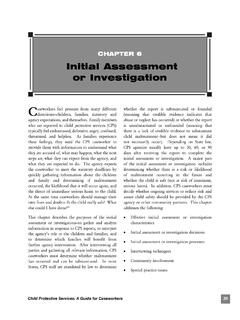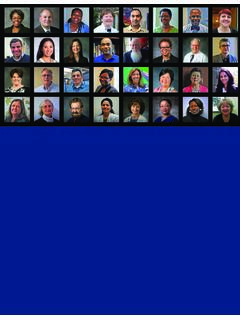Transcription of The California Child Abuse & Neglect Reporting Law
1 Rady Children s Hospital San Diego The California Child Abuse & Neglect Reporting Law Issues and Answers for Mandated Reporters Rev. 6/2012 Rev. 6/2012 Acknowledgements The Chadwick Center and Office of Child Abuse Prevention are grateful to Eliana Gil, , for the work she did as the original author of this publication. We also wish to acknowledge the following people for their contributions: Diane Nissen, MSW, Allyson Kohl, LMFT; Catharine J. Ralph, LCSW; Kim Ralph, MSW, and Patty Lough, MSW, LCSW, Revised by Lisa McCulloch, LCSW Chadwick Center for Children and Families Rady Children s Hospital Rev.
2 6/2012 Rev. 6/2012 Table of Contents Introduction The Reporting Law Identification Environmental Factors Parent/Caregiver Clues Physical Indicators ( Child ) Behavioral Indicators ( Child ) Guidelines to Determining Reasonable Suspicion Cultural Considerations Talking to Children What to Tell Parents/Caretakers Profession-Specific Information Child Care Professionals Clergy Educators Law Enforcement Medical Professionals Mental Health Professionals Children With Disabilities Major Treatment Issues (for Therapists) Frequently Asked Questions References and Resources Appendix A- Suspected Child Abuse Report (Form SS 8572)
3 And Instructions Appendix B- Sample Confidentiality Statements and Agreement Appendix C- Chart summarizing sexual Abuse Reporting requirements based on the age difference between the partner and the minor Appendix D- Statewide and National Resources Appendix E- Profession-Specific References/Resources Rev. 6/2012 Page 1 Document Title Introduction This handbook was originally written to help mental health professionals understand the Child Abuse Reporting Law and their Reporting responsibilities, and to identify and address major treatment issues.
4 This revised edition also includes issues specific to various other professionals, specifically: Child care providers, clergy, educators, law enforcement, and medical professionals. Information about working with children with disabilities and the mandated Reporting process is also included. For the mandated reporter, making a report of suspected Child Abuse can be difficult. Concerns about how the person suspected of abusing a Child will react, what the outcome will be, and whether or not the report will put the Child at greater risk are often present.
5 The best way to minimize the difficulty of Reporting is to be fully prepared for the experience. Mandated reporters should be knowledgeable about Reporting requirements and the process that is triggered when a report is made. Responding to suspected Child Abuse requires a team effort involving professionals from a variety of disciplines including Child protection workers, law enforcement, medical personnel, and mental health professionals. Information contained in this publication is offered as an aid to mandated reporters in Reporting suspected Child Abuse .
6 It clarifies basic information. It is not meant to be all-inclusive or to cover all situations, nor should it be considered legal advice. Because mandated reporters include individuals in a variety of professions, it is important to be educated about protocols and issues specific to your profession. When in doubt about what to do in a particular situation, contact your local Child welfare agency and/or law enforcement agency. Additional resources, including toll free numbers and web sites, are listed in the Appendix section.
7 Issues and Answers for Mandated Reporters Rev. 6/2012 Page 2 Document Title The Reporting Law The first Child Abuse Reporting law in California , enacted in 1963, pertained only to physicians. It mandated that physicians report evidence of physical Abuse . As knowledge and understanding of Child Abuse increased over time, it became evident that other professionals might also be in a position to identify maltreatment. This led to a substantial increase in the number of professional groups designated in state laws as mandated reporters.
8 The expansion of the ranks of mandated reporters was accompanied by a broadening of the concept of reportable maltreatment to include sexual Abuse , emotional maltreatment, and Neglect . The Child Abuse and Neglect Reporting Act (CANRA) was passed in 1980. Over the years, numerous amendments have expanded the definition of Child Abuse and the persons required to report. Procedures for Reporting have also been clarified. In California , certain professionals are required to report known or suspected Child Abuse . Other citizens, though not required by law to report, may also do so.
9 It is important for mandated reporters to stay abreast of periodic amendments in the law. Your local Child Abuse Prevention Council or Child Protective Agency has current Reporting law information. Issues and Answers for Mandated Reporters Page 3 Document Title 1. Why Must You Report? The primary intent of the Reporting law is to protect the Child . Protecting the identified victim may also provide the opportunity to protect other potential victims. It is equally important to provide help for the suspected abuser.
10 The report of Abuse may be a catalyst for bringing about change in the home environment, which in turn may lower the risk of Abuse . 2. What is Child Abuse ? Child Abuse and Neglect , as defined in CANRA, includes: physical Abuse , sexual Abuse (including both sexual assault and sexual exploitation), willful cruelty or unjustified punishment, unlawful corporal punishment or injury, and Neglect (including both acts and omissions). Under current law, Child Abuse does not include A mutual affray between minors. (PC ) Reasonable and necessary force used by a peace officer acting within the course and scope of his or her employment as a peace officer.



